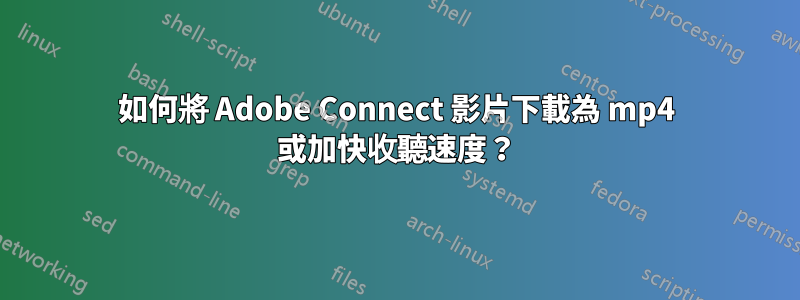
如何將 Adobe Connect 影片下載為 mp4 或加快收聽速度?
想法:
以某種方式破解我的計算機,以便透過讓 CPU 或 Chrome Flash Player 應用程式的時間過得更快來加快視訊播放速度。我認為至少對於視頻來說這是可能的,對於聲音來說,我希望這不會改變它的音調。我的作業系統是基於 Debian 的 Linux 版本。
螢幕記錄整個過程,但這仍然很乏味,因為它需要我有一台專門的計算機來運行,我不能同時做其他事情。
使用現有的
/output/filename.zip?download=ziphack 將其附加到 URL 來下載影片。但這會導致 zip 檔案充滿 17 個(或更多)內容,.flv並且.xml檔案包含分離的音訊和視訊。我搜尋了一個工具可以將這些視頻轉換回常規視頻,但沒有找到任何有用的東西。我發現那些煩人且刺耳的檔案與已經下載到瀏覽器快取中用於播放的檔案相同。要求每位教授解鎖 mp4 下載,例如啟用使用而不是苛刻的 zip 檔案的
/output/filename.mp4?download=mp4可能性download=mp4。但我擔心這會要求他們允許任何人在其管理設置中公開訪問他們的視頻,所以我不確定這是否適合他們。
答案1
假設 Adobe Connect ID 為 p6vwxp2d0c2f,即 URL 為https://my.adobeconnect.com/p6vwxp2d0c2f。正如您在問題中提到的,您可以/output/p6vwxp2d0c2f.zip?download=zip在 URL 末尾添加以下載一些包含一堆音訊和視訊檔案以及一些 .xml 檔案的 zip 檔案。例如,https://my.adobeconnect.com/p6vwxp2d0c2e/output/p6vwxp2d0c2e.zip?download=zip可能包含:
Directory of C:\Users\[...]\p6vwxp2d0c2f
02/09/2019 11:27 AM <DIR> .
02/09/2019 11:27 AM <DIR> ..
02/09/2019 11:00 AM 52,239,473 cameraVoip_1_11.flv
02/09/2019 11:00 AM 1,364,573 cameraVoip_1_11.xml
02/09/2019 11:00 AM 7,176,904 cameraVoip_1_15.flv
02/09/2019 11:00 AM 188,012 cameraVoip_1_15.xml
02/09/2019 11:00 AM 6,004 cameraVoip_1_3.flv
02/09/2019 11:00 AM 1,698 cameraVoip_1_3.xml
02/09/2019 11:00 AM 62,603,505 cameraVoip_1_7.flv
02/09/2019 11:00 AM 1,625,383 cameraVoip_1_7.xml
02/09/2019 11:00 AM 2,249 ftcontent1.flv
02/09/2019 11:00 AM 8,219 ftcontent1.xml
02/09/2019 11:00 AM 25,685 ftcontent13.flv
02/09/2019 11:00 AM 85,464 ftcontent13.xml
02/09/2019 11:00 AM 199,781 ftcontent5.flv
02/09/2019 11:00 AM 657,091 ftcontent5.xml
02/09/2019 11:00 AM 182,297 ftcontent9.flv
02/09/2019 11:00 AM 601,758 ftcontent9.xml
02/09/2019 11:00 AM 1,354 fttitle0.flv
02/09/2019 11:00 AM 3,272 fttitle0.xml
02/09/2019 11:00 AM 1,354 fttitle12.flv
02/09/2019 11:00 AM 3,298 fttitle12.xml
02/09/2019 11:00 AM 1,354 fttitle4.flv
02/09/2019 11:00 AM 3,290 fttitle4.xml
02/09/2019 11:00 AM 1,354 fttitle8.flv
02/09/2019 11:00 AM 3,298 fttitle8.xml
02/09/2019 11:00 AM 1,815,158 indexstream.flv
02/09/2019 11:00 AM 7,703,603 indexstream.xml
02/09/2019 11:00 AM 5,316,597 mainstream.flv
02/09/2019 11:00 AM 21,259,001 mainstream.xml
02/09/2019 11:00 AM 217,448,561 screenshare_2_10.flv
02/09/2019 11:01 AM 1,364,572 screenshare_2_10.xml
02/09/2019 11:01 AM 32,364,457 screenshare_2_14.flv
02/09/2019 11:01 AM 188,011 screenshare_2_14.xml
02/09/2019 11:01 AM 387,981 screenshare_2_2.flv
02/09/2019 11:01 AM 1,698 screenshare_2_2.xml
02/09/2019 11:01 AM 237,470,572 screenshare_2_6.flv
02/09/2019 11:01 AM 1,625,385 screenshare_2_6.xml
02/09/2019 11:01 AM 48 telephony-files.xml
02/09/2019 11:01 AM 691 transcriptstream.flv
02/09/2019 11:01 AM 2,391 transcriptstream.xml
39 File(s) 653,935,396 bytes
2 Dir(s) 1,590,358,016 bytes free
- 攝影機Voip__.xml 包含音訊+網路攝影機(如果有)。
- 螢幕分享__.xml 包含音訊+網路攝影機(如果有)。
要合併它們,您可以使用ffmpeg(我ffmpeg從 Oliver Wang / Yannick Hold-Geoffroy / Aaron Hertzmann 那裡獲取命令):
ffmpeg -i cameraVoip_1_11.flv -i screenshare_2_10.flv -c copy -map 0:a:0 -map 1:v:0 -shortest output.flv
在哪裡:
-map 0:a:0:映射僅用於音訊的第一個輸入檔。-map 1:v:0:映射僅用於影片的第二個輸入檔。-shortest:剪切音頻或視頻,以防cameraVoip_1_11.flv和screenshare_2_10.flv長度不同。
如果您想保留網路攝影機影片並將其放置在視訊螢幕共享的某個角落:
ffmpeg -i cameraVoip_1_11.flv -i screenshare_2_10.flv \
-filter_complex \
"color=s=1072x480:c=black [base]; [0:v] setpts=PTS-STARTPTS, scale=640x480 [upperleft]; [1:v] setpts=PTS-STARTPTS, scale=432x240 [upperright]; [base][upperleft] overlay=shortest=1 [tmp1]; [tmp1][upperright] overlay=shortest=1:x=640" \
-c:v libx264 -c:a mp2 output.mkv
關於映射cameraVoip__.xml 到正確的螢幕共享__.xml,如果有多個:
人們可以看一下攝影機Voip__.xml/螢幕分享__.xml 取得音訊/螢幕分享視訊開始的時間戳記。這允許映射螢幕共享__.xml 與正確的cameraVoip__.xml。
例如,在https://my.adobeconnect.com/p6vwxp2d0c2f/output/p6vwxp2d0c2f.zip?download=zip,來自cameraVoip_1_11.xml,第21行:
<String><![CDATA[Thu Feb 07 21:11:23 2019]]></String>
否則,另一種方法可能是對cameraVoip_進行排序_.xml/螢幕分享__.xml,然後映射第一個cameraVoip__.xml 與第一個畫面共用__.xml,第二個cameraVoip__.xml 與第一個畫面共用__我不知道在某些情況下它是否會中斷(對於我查看的幾個 Adobe Connect 記錄似乎沒問題,但也許這是因為人們總是共享螢幕)。
我編寫了一些 python 腳本來自動化這個過程(程式碼倉庫:https://github.com/Franck-Dernoncourt/adobe-connect-video-downloader):
'''
Requirements:
- python 2.7 or 3
- wget, unzip, and ffmpeg accessible from command line.
Examples:
python connect2vid_v2.py https://my.adobeconnect.com/pqc06mcawjgn/ --output_filename=" Understanding how the Network impacts your service"
Please email Franck Dernoncourt <[email protected]> if you improve this code.
'''
import shlex
import subprocess
import os
import glob
import argparse
import sys
import re
def run_command(command):
print('running command: {0}'.format(command))
process = subprocess.Popen(shlex.split(command), stdout=subprocess.PIPE)
while True:
output = process.stdout.readline()
print(output.strip())
if output == b'' and process.poll() is not None:
print('Done running the command.')
break
if output:
print(output.strip())
rc = process.poll()
return rc
def create_folder_if_not_exists(directory):
'''
Create the folder if it doesn't exist already.
'''
if not os.path.exists(directory):
os.makedirs(directory)
def extract_connect_id(parser, args):
'''
Function written by Aaron Hertzmann
'''
# ----- extract the connectID or ZIP file -----
if len(args.URLorIDorZIP) < 1:
# print('Error: No Connect recording URL provided.')
parser.print_help()
sys.exit(0)
if args.URLorIDorZIP[0][-4:].lower() == '.zip':
sourceZIP = args.URLorIDorZIP[0]
connectID = os.path.basename(sourceZIP[:-4])
elif len(args.URLorIDorZIP[0]) == 12:
connectID = args.URLorIDorZIP[0]
else:
s = args.URLorIDorZIP[0].split('/')
connectID = None
for i in range(len(s)-1):
if 'adobeconnect.com' in s[i]:
connectID = s[i+1]
break
if connectID == None:
print("Error: couldn't parse URL")
sys.exit(1)
return connectID
def main():
'''
This is the main function
'''
# ================ parse the arguments (part of the parsing code was written by Aaron Hertzmann) ======================
parser = argparse.ArgumentParser(description='Download an Adobe Connect recording and convert to a video file.')
parser.add_argument('URLorIDorZIP', nargs='*', help='URL, code, or ZIP file for the Connect recording')
parser.add_argument('--output_folder',default='output_videos',help='Folder for output files')
parser.add_argument('--output_filename',default='noname', help='output_filename')
args = parser.parse_args()
#main_output_folder = "all_videos"
main_output_folder = args.output_folder
output_filename = args.output_filename
output_filename = re.sub(r'[^\w\s]','', output_filename)
output_filename = output_filename.replace('@', '').strip()
print('output_filename: {0}'.format(output_filename))
connect_id = 'pul1pgdvpr87'
connect_id = 'p6vwxp2d0c2f'
connect_id = extract_connect_id(parser, args)
video_filename = 'hello'
video_filename = output_filename
# ================ Download video ======================
output_folder = connect_id
output_zip_filename = '{0}.zip'.format(connect_id)
create_folder_if_not_exists(output_folder)
create_folder_if_not_exists(main_output_folder)
# Step 1: retrieve audio and video files
connect_zip_url = 'https://my.adobeconnect.com/{0}/output/{0}.zip?download=zip'.format(connect_id)
wget_command = 'wget -nc -O {1} {0}'.format(connect_zip_url, output_zip_filename) # -nc, --no-clobber: skip downloads that would download to existing files.
run_command(wget_command)
unzip_command = 'unzip -n {0} -d {1}'.format(output_zip_filename, output_folder) # -n: Unzip only newer files.
run_command(unzip_command)
# Step 2: create final video output
cameraVoip_filepaths = []
for filepaths in sorted(glob.glob(os.path.join(output_folder, 'cameraVoip_*.flv'))):
cameraVoip_filepaths.append(filepaths)
print('cameraVoip_filepaths: {0}'.format(cameraVoip_filepaths))
screenshare_filepaths = []
for filepaths in sorted(glob.glob(os.path.join(output_folder, 'screenshare_*.flv'))):
screenshare_filepaths.append(filepaths)
part = 0
output_filepaths = []
for cameraVoip_filepath, screenshare_filepath in zip(cameraVoip_filepaths, screenshare_filepaths):
output_filepath = os.path.join(main_output_folder, '{0}_{1:04d}.flv'.format(video_filename, part))
#output_filepath = '{0}_{1:04d}.flv'.format(video_filename, part)
output_filepaths.append(output_filepath)
# ffmpeg command from Oliver Wang / Yannick Hold-Geoffroy / Aaron Hertzmann
conversion_command = 'ffmpeg -i "%s" -i "%s" -c copy -map 0:a:0 -map 1:v:0 -shortest -y "%s"'%(cameraVoip_filepath, screenshare_filepath, output_filepath)
# -y: override output file if exists
run_command(conversion_command)
part += 1
# Concatenate all videos into one single video
# https://stackoverflow.com/questions/7333232/how-to-concatenate-two-mp4-files-using-ffmpeg
video_list_filename = 'video_list.txt'
video_list_file = open(video_list_filename, 'w')
for output_filepath in output_filepaths:
video_list_file.write("file '{0}'\n".format(output_filepath))
video_list_file.close()
final_output_filepath = '{0}.flv'.format(video_filename)
# ffmpeg command from Oliver Wang / Yannick Hold-Geoffroy / Aaron Hertzmann
conversion_command = 'ffmpeg -safe 0 -y -f concat -i "{1}" -c copy "{0}"'.format(final_output_filepath, video_list_filename)
run_command(conversion_command)
#os.remove(video_list_filename)
if __name__ == "__main__":
main()
#cProfile.run('main()') # if you want to do some profiling


